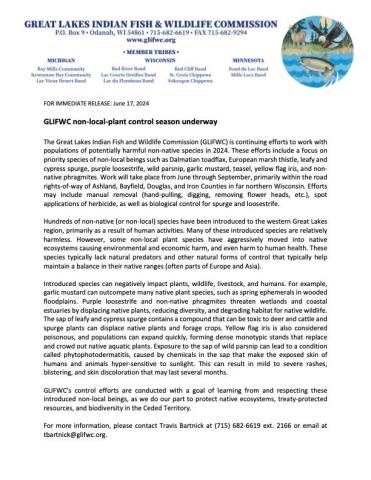
The Great Lakes Indian Fish and Wildlife Commission (GLIFWC) is continuing efforts to work with populations of potentially harmful non-native species in 2024. These efforts include a focus on priority species of non-local beings such as Dalmatian toadflax, European marsh thistle, leafy and cypress spurge, purple loosestrife, wild parsnip, garlic mustard, teasel, yellow flag iris, and non- native phragmites. Work will take place from June through September, primarily within the road rights-of-way of Ashland, Bayfield, Douglas, and Iron Counties in far northern Wisconsin. Efforts may include manual removal (hand-pulling, digging, removing flower heads, etc.), spot applications of herbicide, as well as biological control for spurge and loosestrife. Hundreds of non-native (or non-local) species have been introduced to the western Great Lakes region, primarily as a result of human activities. Many of these introduced species are relatively harmless.
However, some non-local plant species have aggressively moved into native ecosystems causing environmental and economic harm, and even harm to human health. These species typically lack natural predators and other natural forms of control that typically help maintain a balance in their native ranges (often parts of Europe and Asia). Introduced species can negatively impact plants, wildlife, livestock, and humans. For example, garlic mustard can outcompete many native plant species, such as spring ephemerals in wooded floodplains. Purple loosestrife and non-native phragmites threaten wetlands and coastal estuaries by displacing native plants, reducing diversity, and degrading habitat for native wildlife.
The sap of leafy and cypress spurge contains a compound that can be toxic to deer and cattle and spurge plants can displace native plants and forage crops. Yellow flag iris is also considered poisonous, and populations can expand quickly, forming dense monotypic stands that replace and crowd out native aquatic plants. Exposure to the sap of wild parsnip can lead to a condition called phytophotodermatitis, caused by chemicals in the sap that make the exposed skin of humans and animals hyper-sensitive to sunlight. This can result in mild to severe rashes, blistering, and skin discoloration that may last several months. GLIFWC's control efforts are conducted with a goal of learning from and respecting these introduced non-local beings, as we do our part to protect native ecosystems, treaty-protected resources, and biodiversity in the Ceded Territory. For more information, please contact Travis Bartnick at (715) 682-6619 ext. 2166 or email at tbartnick@glifwc.org.